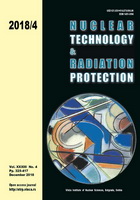
UTILIZING MONTE CARLO SIMULATIONS IN ESTIMATION OF OCCUPATIONAL EYE LENS DOSE BASED ON WHOLE BODY DOSIMETER IN INTERVENTIONAL CARDIOLOGY AND RADIOLOGY

Vol.
XXXIII, No. 4, Pp. 325-417
December 2018
UDC 621.039+614.876:504.06
ISSN 1451-3994
Pages: 375-379
Authors: Predrag M. Božović, Olivera F. Ciraj-Bjelac, Jelena S. Stanković Petrović, Danijela D. Aranđić, and Sandra M.ČeklićAbstract
Medical staff performing interventional procedures in cardiology and radiology is considered to be a professional group exposed to high doses of ionizing radiation. With new epidemiological evidences and recently reduced eye lens dose limit, dose assessment to the lens of the eye, in the interventional cardiology, has become one of the most challenging research topics. This paper presents results of the eye lens dose assessment in interventional cardiology obtained by means of the computational dosimetry. Since placing and wearing the dedicated eye lens dosimeter is encumbering for the staff, Monte Carlo simulation provides an accurate and efficient method for obtaining an indication of doses to the eye lenses. Eye lens doses were estimated for three typical beam projections (PA, LAO, and RAO) and tube voltages ranging from 80 kV to 110 kV, with different protective equipment setups, for the first operator position. Simulations were carried out using MCNPX code. Results revealed that a whole body dosimeter worn at the thyroid center position gives the best estimate of the eye lens dose with a spread from 11 % to 18 % for the left eye. Corresponding average conversion coefficient from whole body to the eye lens dose is estimated to be 0.18.
Key words: eye lens dose, interventional cardiology, X-ray, scattered radiation, Monte Carlo method
FULL PAPER IN PDF FORMAT (983 KB)